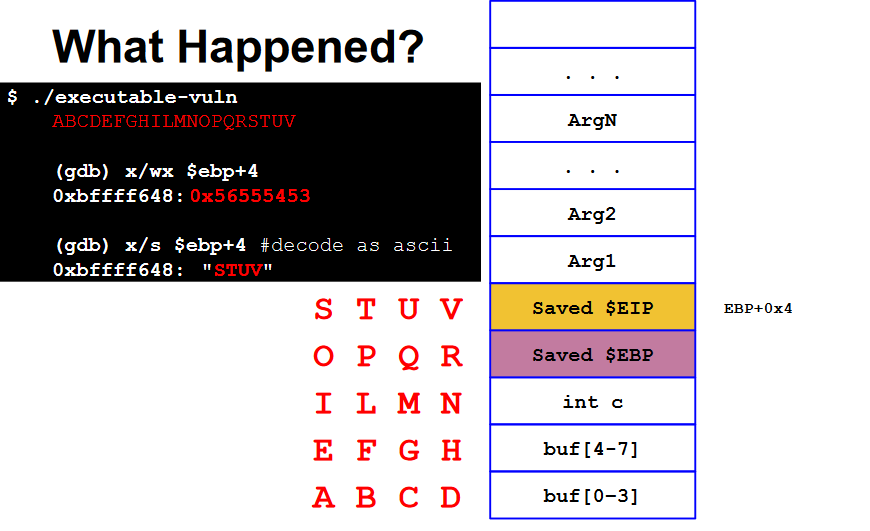Buffer overflows
A function foo() allocates a buffer, e.g., char buf[8]. buf is filled without size checking.
int foo(int a, int b)
{
int c = 14;
char buf[8];
gets(buf); //security bug -> vulnerability
c = (a + b) * c;
return c;
}
If we fille the buf and overwrite the saved EIP:

jmp 0x56555453 jump to invalid address (for the current process) so the program crashes.
Where to jump?
We need to jump to a valid memory location that contains, or can be filled with, valid executable machine code.
There are different exploitation techniques:
- Environment variable
- Built-in, existing functions
- Memory that we can control
- The buffer itself (what we will see)
- Some other variable
Stack Smashing 101
Let's assume that the overflowed buffer has enough room for our arbitrary machine code.
How do we guess the buffer address?
- Somewhere around ESP: gdb?
- unluckily, exact address may change at each execution and/or from machine to machine.
- the CPU is dumb: off-by-one wrong and it will fail to fetch and execute, possibly crashing.
In practice the ESP value is read:
- Use a debugger:
(gdb) p/x $esp. Most debuggers add an offset, so the ESP differs a few words. - Read from a process
NOP Sled
A "landing strip" such that:
- Wherever we fall, we find a valid instruction
- We eventually reach the end of this area and the executable code
Sequence of NOP at the beginning of the buffer
- NOP is a 1-byte instruction (0x90 on x86), which does nothing at all
We will need to jump anywhere within the nopsled (somewhere in the middle).
What to execute?
Historically, goal of the attacker: to spawn a (privileged) shell (on a local/remote machine).
(Shell)code: sequence of machine instructions (that are needed to open a shell) In general, a shellcode may do just anything (e.g., open a TCP connection, launch a VPN server, a reverse shell).
Basically: execute execve("/bin/sh") system call.
In Linux, a system call is invoked by executing
a software interrupt through the int instruction
passing the 0x80 value (or the equivalent
instructions):
-
movl $syscall_number, eax - Syscall arguments //GP registers (ebc, ecx,edx)
-
mov arg1, %ebx -
mov arg2, %ecx -
mov arg3, %edx
-
-
int 0x80//Switch to kernel mode - Syscall is executed
The steps to write shellcode are:
- Write high level code
- Compile and disassembly
- Analyze and clean up assembly
- Extract Opcode
- Create the shellcode
Alternative exploits
We showed this with the overflowed buffer, but can be done with other memory areas too.
| PROS | CONS |
|---|---|
| Can do this remotely | Buffer could not be large enough Memory must be marked as executable Need to guess the address reliably |
Environment Variable
int main(int argc, char *argv[], char *envp[])
We allocate an area of memory that contains the exploit.
Then, we put the content of that memory in an environment variable named $EGG.
Finally, we have to overwrite the EIP with the address of $EGG by filling the buffer.
| PROS | CONS |
|---|---|
| Easy to implement Easy to target |
Works for local exploiting only! The program may wipe the environment Memory must be marked as executable |
Built-in, Existing Function
The address of a system library or function (e.g., return to libc attack).
| PROS | CONS |
|---|---|
| Works remotely and reliably No need for executable stack A function is executable usually |
Need to prepare the stack frame carefully |
Alternatives for overwriting
- Saved EIP (direct jump) (what we saw):
retwill jump to our code - Function Pointer (call another function):
jmpto another function - Saved EBP (frame teleportation):
pop $ebpwill restore another frame
Defending against buffer overflows
A multilayered approach to defense is used:
- Defenses at source code level: finding and removing the vulnerabilities
- Defenses at compiler level: making vulnerabilities non exploitable
- Defenses at operating system level
Defenses at Source Code Level
Programmer errors cause buffer overflows. It is possible to limit these errors:
- Education of developers
- System Dev. Life Cycle (SDLC)
- Targeted testing
- Use of source code analyzers
- Using safe(r) libraries: Standard Library strncpy, strncat, etc. (with length parameter)
- Using languages with Dynamic memory management (e.g., Java) that makes them more resilient to these issues.
Compiler Level Defenses
- Warnings at compile time
- Randomized reordering of stack variables
- Embedding stack protection mechanisms at compile time
Canaries
Canaries are stack protection mechanisms embedded at compile time.
The goual is to verify, during the epilogue, that the frame has not been tampered with.
Usually a canary is inserted between local
variables and control values (saved EIP/EBP) and when the function returns, the canary is checked
and if tampering is detected the program is killed.

There are different type of canaries:
- Terminator canaries: made with terminator characters (typically \0) which cannot be copied by string-copy functions and therefore cannot be overwritten
- Random canaries: random sequence of bytes, chosen when the program is run
- Random XOR canaries: same as above, but canaries XORed with part of the structure that we want to protect - protects against non-overflows
OS Level Defenses
-
Non-executable stack
- No stack smashing or local variables
- The hardware NX bit mechanism is used
- Bypass: don’t inject code, but point the return address to existing machine instructions (code-reuse attacks), called return oriented programming (ROP)
-
Address Space Layout Randomization (ASLR)
- Repositioning the stack, among other things, at each execution at random; impossible to guess return addresses correctly







No Comments